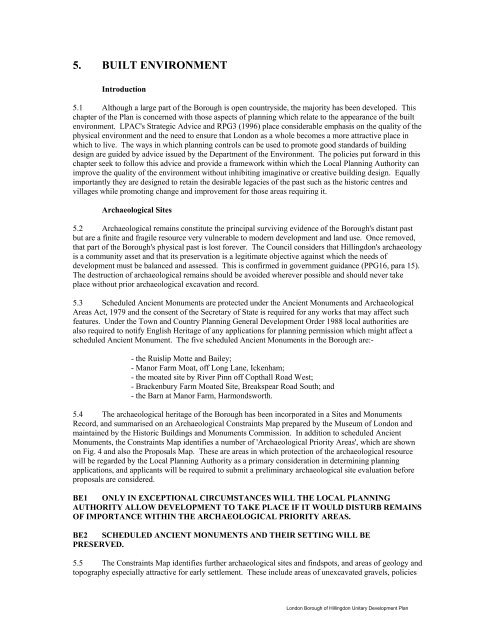HILLINGDON UNITARY DEVELOPMENT PLAN - London Borough ...
HILLINGDON UNITARY DEVELOPMENT PLAN - London Borough ...
HILLINGDON UNITARY DEVELOPMENT PLAN - London Borough ...
You also want an ePaper? Increase the reach of your titles
YUMPU automatically turns print PDFs into web optimized ePapers that Google loves.
5. BUILT ENVIRONMENT<br />
Introduction<br />
5.1 Although a large part of the <strong>Borough</strong> is open countryside, the majority has been developed. This<br />
chapter of the Plan is concerned with those aspects of planning which relate to the appearance of the built<br />
environment. LPAC's Strategic Advice and RPG3 (1996) place considerable emphasis on the quality of the<br />
physical environment and the need to ensure that <strong>London</strong> as a whole becomes a more attractive place in<br />
which to live. The ways in which planning controls can be used to promote good standards of building<br />
design are guided by advice issued by the Department of the Environment. The policies put forward in this<br />
chapter seek to follow this advice and provide a framework within which the Local Planning Authority can<br />
improve the quality of the environment without inhibiting imaginative or creative building design. Equally<br />
importantly they are designed to retain the desirable legacies of the past such as the historic centres and<br />
villages while promoting change and improvement for those areas requiring it.<br />
Archaeological Sites<br />
5.2 Archaeological remains constitute the principal surviving evidence of the <strong>Borough</strong>'s distant past<br />
but are a finite and fragile resource very vulnerable to modern development and land use. Once removed,<br />
that part of the <strong>Borough</strong>'s physical past is lost forever. The Council considers that Hillingdon's archaeology<br />
is a community asset and that its preservation is a legitimate objective against which the needs of<br />
development must be balanced and assessed. This is confirmed in government guidance (PPG16, para 15).<br />
The destruction of archaeological remains should be avoided wherever possible and should never take<br />
place without prior archaeological excavation and record.<br />
5.3 Scheduled Ancient Monuments are protected under the Ancient Monuments and Archaeological<br />
Areas Act, 1979 and the consent of the Secretary of State is required for any works that may affect such<br />
features. Under the Town and Country Planning General Development Order 1988 local authorities are<br />
also required to notify English Heritage of any applications for planning permission which might affect a<br />
scheduled Ancient Monument. The five scheduled Ancient Monuments in the <strong>Borough</strong> are:-<br />
- the Ruislip Motte and Bailey;<br />
- Manor Farm Moat, off Long Lane, Ickenham;<br />
- the moated site by River Pinn off Copthall Road West;<br />
- Brackenbury Farm Moated Site, Breakspear Road South; and<br />
- the Barn at Manor Farm, Harmondsworth.<br />
5.4 The archaeological heritage of the <strong>Borough</strong> has been incorporated in a Sites and Monuments<br />
Record, and summarised on an Archaeological Constraints Map prepared by the Museum of <strong>London</strong> and<br />
maintained by the Historic Buildings and Monuments Commission. In addition to scheduled Ancient<br />
Monuments, the Constraints Map identifies a number of 'Archaeological Priority Areas', which are shown<br />
on Fig. 4 and also the Proposals Map. These are areas in which protection of the archaeological resource<br />
will be regarded by the Local Planning Authority as a primary consideration in determining planning<br />
applications, and applicants will be required to submit a preliminary archaeological site evaluation before<br />
proposals are considered.<br />
BE1 ONLY IN EXCEPTIONAL CIRCUMSTANCES WILL THE LOCAL <strong>PLAN</strong>NING<br />
AUTHORITY ALLOW <strong>DEVELOPMENT</strong> TO TAKE PLACE IF IT WOULD DISTURB REMAINS<br />
OF IMPORTANCE WITHIN THE ARCHAEOLOGICAL PRIORITY AREAS.<br />
BE2 SCHEDULED ANCIENT MONUMENTS AND THEIR SETTING WILL BE<br />
PRESERVED.<br />
5.5 The Constraints Map identifies further archaeological sites and findspots, and areas of geology and<br />
topography especially attractive for early settlement. These include areas of unexcavated gravels, policies<br />
<strong>London</strong> <strong>Borough</strong> of Hillingdon Unitary Development Plan
















